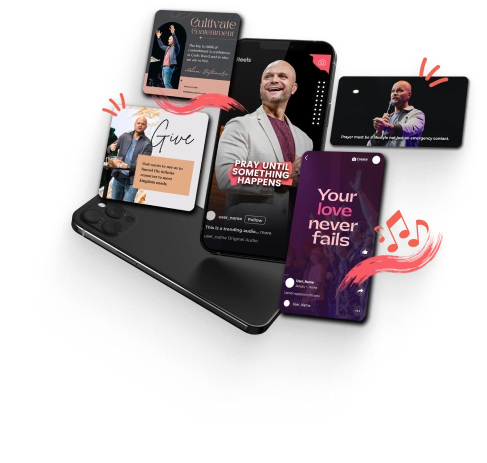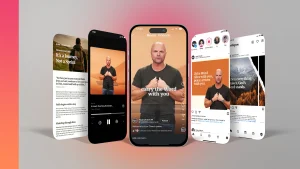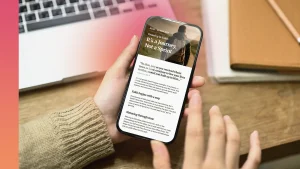Church newsletters have long been a trusted way to connect with members and share important updates. But as our communication habits shift, email is quickly becoming the smarter, more efficient option. Transitioning from print to email isn’t just about saving money—it can make your message more timely and reach more people. In this post, we’ll explore practical steps to make the switch simple and effective.
Understanding the Shift from Print to Email
The way we communicate has changed dramatically over the past few decades, and churches are no exception. Church newsletters, once dominated by printed pages, are now transitioning to email. This isn’t just about keeping up with the times—it’s about staying connected with your congregation in a way that’s faster, cheaper, and more convenient. Let’s break down why this shift matters and what’s driving it.
Why Email Newsletters Are More Effective
Email has completely transformed how we share information. For church newsletters, the benefits are hard to ignore. Here are a few key reasons email outshines print:
Cost-Effectiveness: Printing newsletters can get expensive fast. Paper, ink, and postage add up quickly—especially for larger congregations. Email, on the other hand, eliminates these costs entirely. You can send as many newsletters as you want without worrying about breaking the budget.
Faster Communication: When urgent updates arise, waiting for printing or mailing isn’t practical. Email lets you communicate instantly. Whether it’s announcing a last-minute event or sharing a prayer request, your message reaches everyone in seconds.
Wider Accessibility: Most people have access to email via their phones, tablets, or computers—all day, every day. Unlike printed newsletters that can get lost in the shuffle, email stays in inboxes, ready to be read anytime. Plus, email is easier to share with friends and family, broadening your reach.
Eco-Friendly: Many congregations care deeply about stewardship, which includes caring for the environment. Email reduces paper waste, aligning with these values in a meaningful way.
These advantages make email a powerful tool for deepening engagement with your church community while simplifying how you get the word out.
The Decline of Print Media
Print media isn’t what it used to be. Over the years, trends in how people consume information have shifted significantly. This has important implications for churches relying on traditional newsletters.
Research shows that newspaper subscriptions and magazine circulations have been steadily declining. Why? People now rely on digital platforms for news, updates, and entertainment. Smartphones, social media, and email make staying informed more convenient and immediate than printed materials ever could.
Churches aren’t immune to this trend. Printed newsletters can feel outdated, especially for younger members already accustomed to receiving information online. And let’s be honest—how often do printed newsletters get tossed into recycling bins before they’re even read? For many churches, print media is no longer the best way to stay visible and connected.
By transitioning to email newsletters, you’re meeting members where they already are: online. This shift doesn’t mean abandoning tradition—it means embracing a method that puts your message front and center in a way people are more likely to engage with.
Steps for Transitioning to Email Newsletters
Making the move from printed church newsletters to email might feel like a big leap, but with the right approach, it can be a smooth transition. By focusing on the right tools, design, and audience strategy, you’ll keep your community connected and engaged—without missing a beat.
Choosing the Right Email Platform
Your email platform is the backbone of your digital newsletter. It determines how you send emails, track engagement, and manage your subscriber list. With so many options available, it’s important to find one that fits your church’s needs.
Start by exploring popular platforms like MailChimp, Constant Contact, and ActiveCampaign. Here’s how to evaluate them:
Ease of Use: Does the platform have an intuitive interface? Can a volunteer or team member manage it easily?
Pricing: Most platforms offer tiered pricing based on your list size. Some even include free plans for smaller groups.
Features: Look for tools like automation, email templates, and analytics. These tools help streamline your efforts.
Support Options: Does the platform offer dedicated customer support or tutorials in case you hit a snag?
Take advantage of free trials to test platforms before committing. Pick one that balances your budget, skill level, and features.
Designing Your Email Newsletter
Your email’s design directly impacts how readers engage with your content. A well-designed newsletter captures attention and clearly communicates your message.
Consider these tips for designing effective church newsletters:
Stick to Your Branding: Use your church’s logo, colors, and font styles to create consistency. This reinforces recognition with every email.
Keep It Simple: A clean layout with clear sections works best. Too many images or blocks of text can overwhelm readers.
Use Visual Hierarchy: Prioritize important messages—like upcoming events or prayer requests—by placing them near the top in bold text or larger fonts.
Make It Mobile-Friendly: Most people read emails on their phones. Choose responsive templates and use large, legible text so it’s easy to read on small screens.
Test Before Sending: Always send test emails and proofread carefully. This step ensures everything looks right across devices.
The design doesn’t have to be flashy—clarity and professionalism go a long way in keeping your audience engaged.
Building and Segmenting Your Email List
Transitioning to email newsletters begins with building a solid subscriber base. Encourage church members to provide their email addresses by making it easy and inviting.
Here’s how to get started:
Announce the Change: Share the news during services, in bulletins, and on social media. Let people know why this shift matters.
Create Sign-Up Opportunities: Set up forms on your church website, provide sign-up sheets at events, and include QR codes linking to a subscription page.
Offer Value: Explain what members can expect from the newsletter—event updates, prayer requests, announcements, and more.
Once your list grows, segmentation helps you send the right content to the right people. Divide your audience into groups based on interests, location, or even involvement in church activities.
For example:
Families might want updates on youth programs or childcare services.
Volunteers may need reminders about schedules and meetings.
General Members could receive a broader range of church updates.
Segmentation ensures your messages feel personal and relevant instead of generic. It’s like speaking directly to someone’s needs instead of addressing a crowd.
By focusing on these steps—choosing the right platform, designing an engaging newsletter, and building an organized email list—you’re setting the foundation for a successful transition.
Engaging Your Congregation through Email Newsletters
Switching from print to email newsletters opens the door to connecting with your congregation in fresh, interactive ways. But simply sending out an email isn’t enough—you need to create engaging content that feels personal, relevant, and worth opening. Let’s break down how to make your email newsletters stand out and measure their success.
Crafting Compelling Content
Content is the heart of any church newsletter. Your goal is to inform, inspire, and encourage your audience while keeping them interested. Here are some practical tips for writing and including multimedia:
Write Like You’re Talking to a Friend: Avoid overly formal language. Use a conversational tone, as if you’re chatting over coffee.
Keep Articles Brief and Focused: Long blocks of text can discourage readers. Stick to clear, concise updates or stories—around 150-250 words per section is ideal.
Start with Attention-Grabbing Headlines: Use headlines that make readers curious or excited. Instead of “Upcoming Event,” try “Mark Your Calendar: Special Family Worship Night!”
Mix in Encouragement and Inspiration: Share stories of how your ministry is impacting lives. Highlight personal testimonies or community efforts to uplift your readers.
Include Calls to Action (CTAs): Encourage engagement by guiding readers to take the next step. Whether it’s signing up for an event, joining a Bible study, or donating online, make it easy with links or buttons.
To create a truly dynamic email, incorporate visual elements:
Photos: Include images from recent church events, mission trips, or community outreach programs. A photo says more than a paragraph ever could.
Videos: Short clips from sermons or a pastor’s quick message can add a personal touch. Most email platforms support embedding videos or linking to platforms like YouTube.
Graphics: Create simple announcements or event reminders using free tools like Canva. Graphics help information stand out in a visually appealing way.
Remember, your goal is to make the newsletter something your congregation looks forward to—not just another email they scroll past.
Metrics to Track for Success
How do you know if your email newsletters are effective? It’s all in the numbers. By tracking specific metrics, you can see what’s working and where there’s room for improvement. Keep an eye on these key indicators:
Open Rates
This measures how many people are opening your emails. A low open rate might mean your subject lines need work or your emails are landing in spam folders. Aim for clear, compelling subject lines (e.g., “This Week at First Baptist” or “A Special Message from Pastor Dave”).
Click-Through Rates (CTR)
This tracks how many people are clicking on links within your newsletter. Adding CTAs like “Learn More,” “RSVP Here,” or “Watch the Video” helps boost CTR.
Unsubscribe Rates
If a significant number of people are opting out, revisit your content or email frequency. Are you overwhelming readers, or is the content missing the mark?
Engagement Metrics
Look at how subscribers are engaging with your emails. For example:
Are they replying to prayer requests?
Are they forwarding newsletters to others?
Tools like MailChimp or Constant Contact often provide detailed analytics to track this.
Feedback from Members
Don’t rely solely on data. Ask your congregation what they’d like to see in newsletters. Feedback can help fine-tune your approach and ensure members feel heard.
Think of these metrics as the dashboard for your email strategy. Regularly reviewing them allows you to make adjustments, whether it’s tweaking subject lines, adding more engaging content, or experimenting with sending times.
Combining strong content with data-driven insights is the secret to keeping your church newsletters effective and engaging. Use these strategies to create emails that truly resonate with your congregation and consistently meet their needs.
Overcoming Challenges in the Transition
Transitioning from printed to email newsletters can be a big change for churches, but it doesn’t have to be overwhelming. By addressing common obstacles early on, you’ll make the shift smoother for everyone involved. Let’s tackle two key challenges: technology and maintaining that personal connection your congregation relies on.
Addressing Technological Barriers
One of the biggest hurdles churches face when moving to email newsletters is technology. Not everyone is tech-savvy, and introducing new systems can feel intimidating for both staff and members. So how do you bridge the gap?
Offer Training Sessions: Host a few short workshops for staff, volunteers, or members unfamiliar with email platforms. Focus on the basics—how to open emails, subscribe, or navigate mobile-friendly designs. Keep it hands-on and approachable.
Create a “How-To” Guide: A simple guide with screenshots can go a long way. Show step-by-step instructions for signing up, updating email preferences, and troubleshooting common issues. Distribute these in print for those still making the transition.
Tap Into Volunteers: Every congregation has tech-savvy members willing to help. Ask them to offer one-on-one support or assist during training sessions. Think of it as a ministry opportunity that builds community while solving problems.
Invest in a Reliable Email Platform: Choose a platform that makes it easy for your team to manage newsletters. Look for user-friendly interfaces, templates, and dedicated customer support if you run into roadblocks. Platforms like Constant Contact and Mailchimp are beginner-friendly and widely trusted.
Remember, patience is key. Some members might resist the transition at first, but with ongoing support and reassurance, they’ll feel included and confident in no time.
Maintaining Community Connection
For many churches, print newsletters were more than just updates—they were personal. They felt tangible, heartfelt, and connected readers to the church family. Email can feel impersonal if handled poorly, but it doesn’t have to.
Here’s how to keep the sense of community alive:
Use a Warm, Personal Tone: Write like you’re speaking directly to the reader. Open with a friendly greeting and address them as individuals, not just a group. For example, include phrases like “We’re praying for you this week” or “Here’s something exciting happening in your church.”
Share Stories and Updates: People connect with stories. Highlight real-life examples—new member testimonies, updates on prayer requests, or recaps of recent events. These add a human touch that resonates deeper than bullet points ever could.
Celebrate Milestones: Acknowledge anniversaries, birthdays, or achievements within the congregation. Dedicate a section to spotlight members who’ve impacted church life, just like you might have in a print newsletter.
Encourage Replies: Build interaction into your emails. Add a section inviting readers to respond with prayer requests, comments, or even favorite moments from the past week. This simple gesture makes the communication feel two-way rather than one-sided.
Include Visuals: Photos and videos help evoke emotion and strengthen connection. Share a snapshot of last Sunday’s service or a quick video message from your pastor. These visuals make your newsletter feel vibrant and alive.
The connection doesn’t require paper—it thrives on intentionality. When you focus on making emails relatable, warm, and interactive, members will feel just as valued as they did with printed newsletters.
By addressing these challenges head-on, you’ll turn potential roadblocks into building blocks for a stronger, more connected congregation.
Conclusion
Transitioning church newsletters from print to email offers a chance to reach your congregation effectively and efficiently. By focusing on accessible tools, thoughtful design, and personal engagement, your messages can inspire connection, not just convey information.
The shift may feel challenging, but it’s an opportunity to grow closer to your members in today’s connected world. Take that first step, and watch your church community thrive in new, meaningful ways.
Start today—embrace email and keep your congregation informed, inspired, and engaged.





